Business
California climbers train for Mt. Everest from the comfort of their own beds
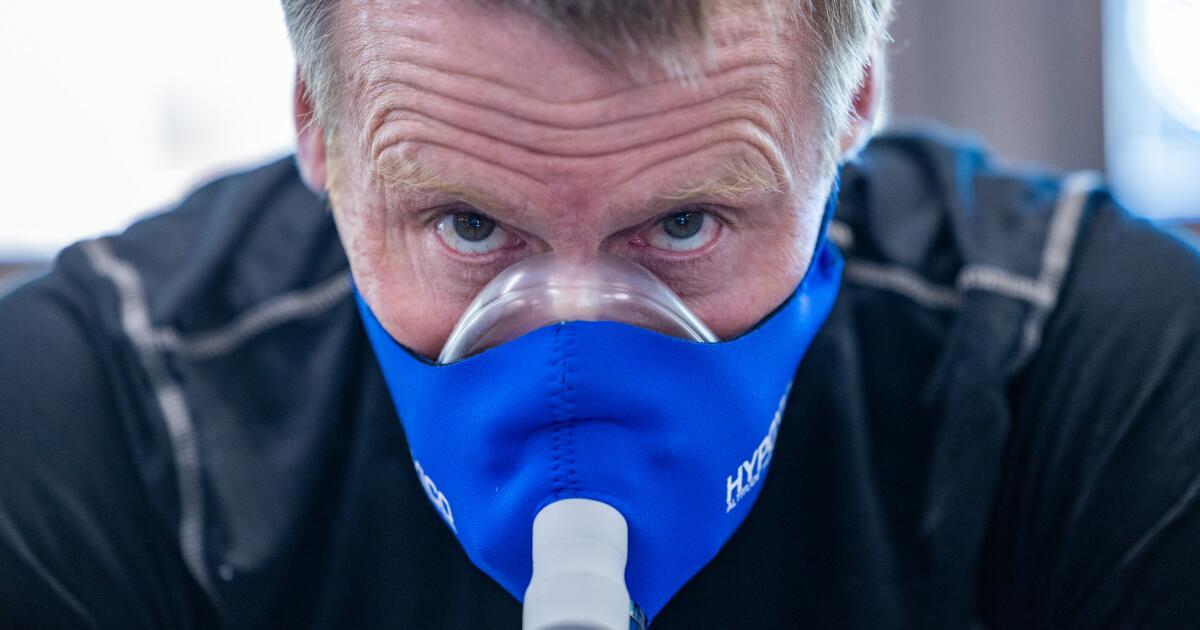
Graham Cooper sleeps with his head in a bag.
Not just any bag. This one has a hose attached to a motor that slowly lowers the oxygen level to mimic, as faithfully as possible, the agonies of fitful sleep at extreme altitude: headaches, dry mouth, cerebral malaise.
“It’s not all bad,” Cooper insisted, nodding to the humming motor. “That’s like white noise.”
Cooper, 54, an Oakland biotech executive who has handled finance for a number of companies, including one that sold for $7 billion, isn’t a masochist, exactly. He’s acclimatizing, in the bedroom of his second home near Lake Tahoe, for an attempt to climb Mt. Everest in May.
Graham Cooper uses a pulse oximeter to check his blood oxygen levels and pulse rate at his Truckee home.
He has signed up with an Olympic Valley-based guide service whose founder, Adrian Ballinger, is breaking with decades of tradition to create what he believes are better and more ethical ways to climb the world’s tallest mountain.
Ballinger said he was appalled by the risks, filth and ballooning crowds on the traditional southern trek up the mountain in Nepal. That’s the route familiar from countless documentaries and books, including the 1997 classic “Into Thin Air.”
So he decided to take clients up on the north side, a journey that starts in Tibet.
“It’s colder, the route is more difficult, and the bureaucracy of dealing with China and getting the permits is a complete nightmare,” Ballinger said. “But despite those things, the Chinese are attempting to regulate, so once you get on the mountain, it’s safer, it’s cleaner, and it’s much less busy.”
Ballinger is also pioneering a technique he calls “rapid ascent,” which cuts the duration of the expedition roughly in half: from about two months to about one. That suits his clients, who usually have more spare money than time. And it buys Ballinger more time to spend at home with his wife and newborn son.
The catch? You have to spend a few months before the trip with your head in the bag.
“It’s not great, I’m not gonna lie,” Ballinger said with a laugh, but the technology is improving.
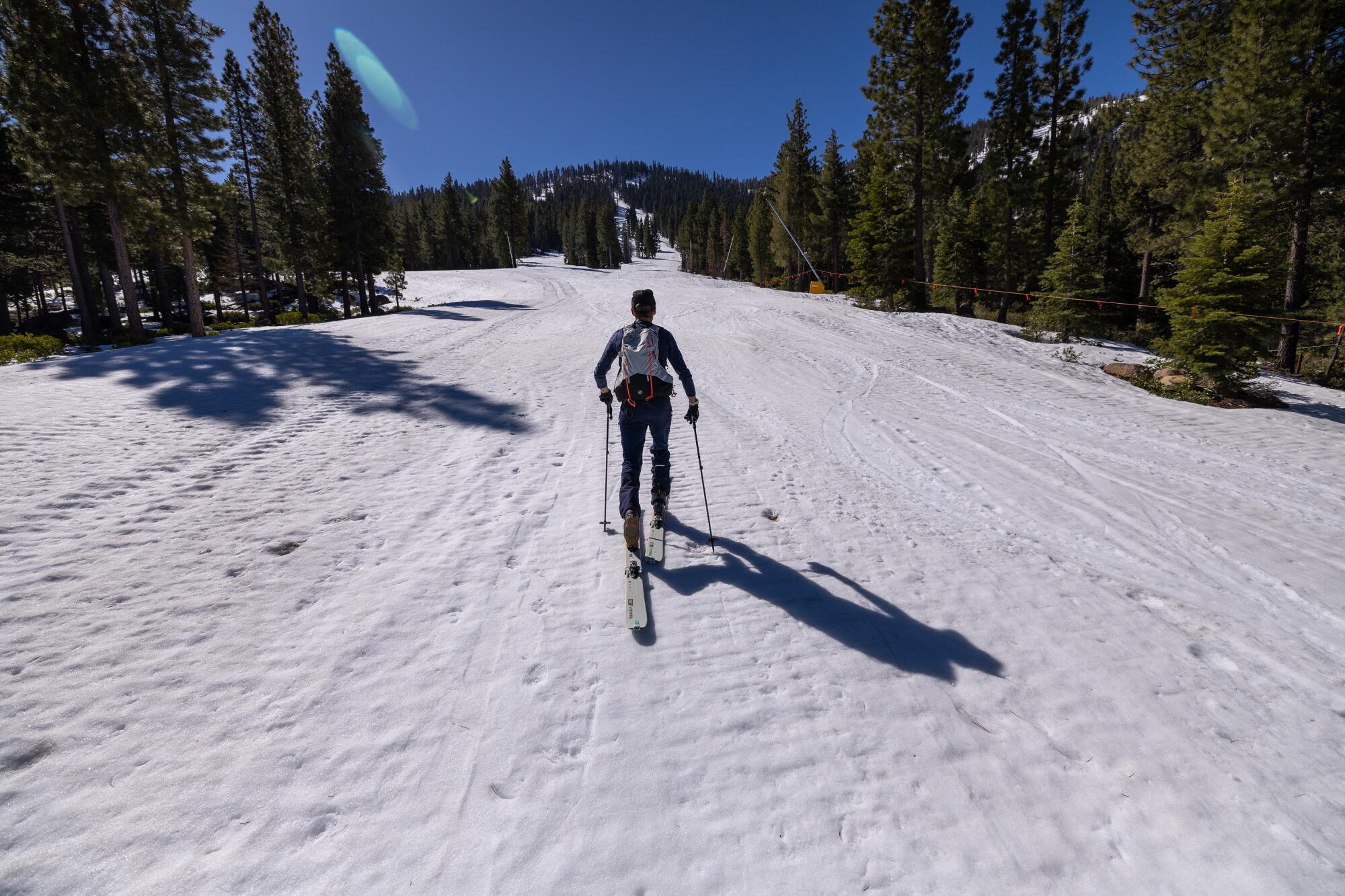
Graham Cooper has been diligently training for his Mt. Everest climb, a regimen that includes skiing laps up and down the slopes near his Truckee home.
(Brian van der Brug / Los Angeles Times)
“Hypoxic tents,” as they’re called, have been used by other endurance athletes for years. In their original form, they would cover a client’s entire bed. That led to difficult conversations with spouses and partners about the necessity of sleeping at progressively higher simulated altitudes until they reached the height of Everest’s base camp, roughly 18,000 feet, where there’s about half the oxygen available at sea level.
As you can imagine, some clients wound up relegated to a couch with their bizarre-looking contraptions.
Cooper, who used one of the enormous old tents preparing for a 2015 trip to climb the highest peaks in Antarctica and South America, confessed he had no luck sweet-talking Hilary, his wife of 28 years, into sharing the adventure. He got bounced to a guest room.
“It was a lonely boy-in-the-bubble experience,” he said. But he has fond memories of the looks on his kids’ faces as they trooped into his little dungeon to kiss him good night.

Graham Cooper relaxes with a book inside an hypoxic tent that slowly lowers the oxygen level to mimic conditions at extreme altitude.
This time around, “the bag,” as he calls it, covers just his head and upper torso and takes up about a quarter of the bed. Hilary sleeps next to him, Cooper said, and she finds the hum of the motor surprisingly soothing.
It goes without saying that the luxury of acclimatizing at home, in bed, with your partner curled up beside you, represents a profound break from the usual manner of preparing to ascend what is still one of the world’s deadliest mountains.
The traditional method starts in Kathmandu, at nearly 5,000 feet, where climbers spend a few days getting over jet lag. That’s usually followed by a quick flight to the small mountain town of Lukla, at just over 9,300 feet. The airport there — perched on a narrow Himalayan shelf surrounded by towering peaks, with a steep drop-off at the end of the runway — is regarded as one of the trickiest places in the world to land an airplane.
From there, climbers begin a long, deliberately slow 10-ish-day hike to base camp. The point is to give the body time to gradually adjust to the lack of oxygen.
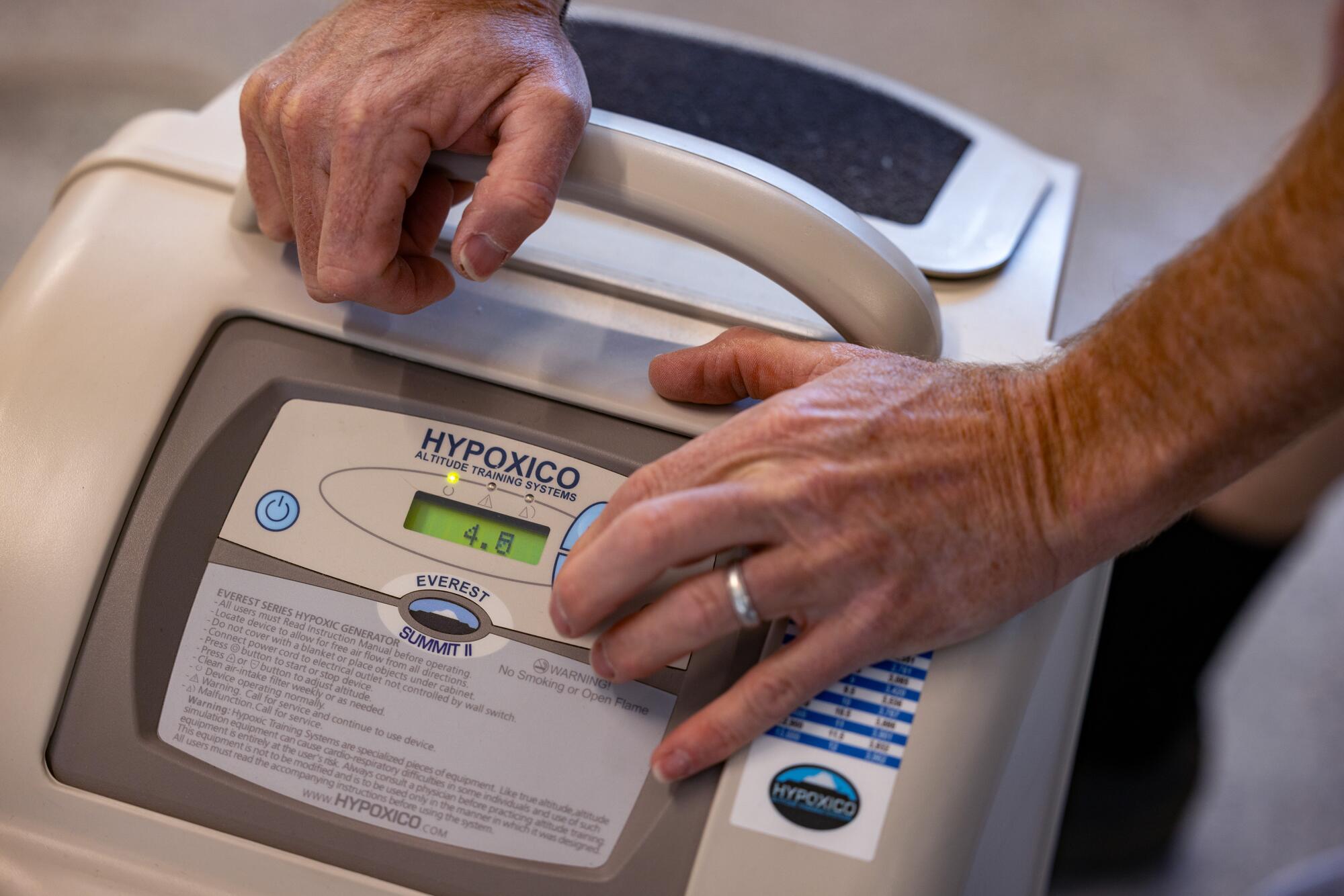
Mountain guide Adrian Ballinger says employing technology that allows clients to acclimatize to high elevations at home has allowed him to cut weeks off their expeditions to Mt. Everest.
Ballinger cuts nearly two weeks from his trips by driving his bedroom-acclimatized clients from the airport in Lhasa, Tibet, straight up to the northern route’s base camp, which is also at about 18,000 feet.
For some old-school purists, eliminating the long walk borders on sacrilege, said Will Cockrell, a journalist whose recent book, “Everest, Inc.,” explores the evolution of commercial guiding on the mountain. “They’ll say, ‘You’re not a real climber; you’re not a real nature lover,’” Cockrell said.
But since the arrival of big commercial expeditions on Everest in the mid-1990s — complete with Sherpas to install climbing ropes, chefs to cook meals in camp, team doctors to monitor health, and guides to accompany clients every step of the way — Mt. Everest has ceased to be a classic off-the-grid mountaineering challenge.
“It has come to represent something completely different,” Cockrell said, “something crazy to do to shake up your life, like running an Ironman.”
Ballinger makes no apologies. “We’re not old school, we don’t spend a lot of time sitting around drinking whiskey and playing cards,” he said.
That suits his clients, who “tend to be pretty type A, pretty high performing in everything they do,” Ballinger said.
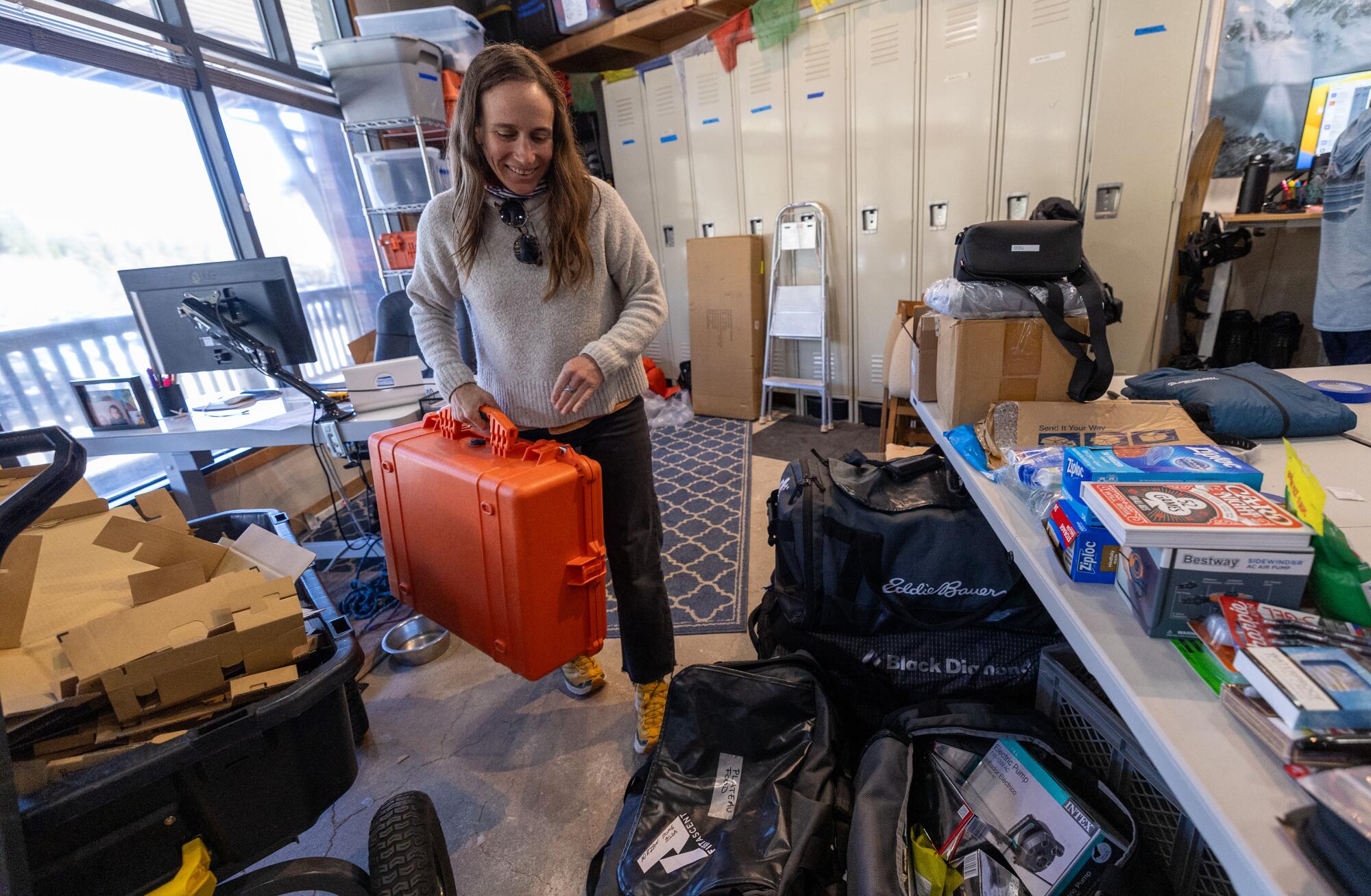
Emily Turner, Alpenglow Expeditions’ Everest base camp manager, organizes supplies for a May trip.
They’d better be. His company, Alpenglow Expeditions, charges $165,000 (before tip) for a private climb, meaning one professionally certified guide per client, and $98,000 for a group climb with three clients per guide.
“We’re proudly expensive,” Ballinger said. “I’ve spent a lot of time thinking about what it takes to run a trip safely and ethically, and this is what it takes.”
Climbing from the north side, as Ballinger does, avoids the huge crowds who flock to the southern base camp from all over the world every May, the prime climbing season on Everest, to wait for a brief window of good weather to try to make it to the summit.
Anyone who has even loosely followed events on Mt. Everest in recent years is probably familiar with the terrifying “conga line” photos of climbers stuck in the world’s highest traffic jam.
It forms just below the summit on the southern route, at the last technical obstacle, a nearly vertical 40-foot rock wall called the Hillary Step. It’s on a ridge with a 10,000-foot drop to the climber’s right and an 8,000-foot drop to the left. So, when exhausted and inexperienced climbers inevitably struggle there, everybody else waits in a single file, hanging onto a fixed rope, while the bottled oxygen they need to survive at that altitude slowly drains away.
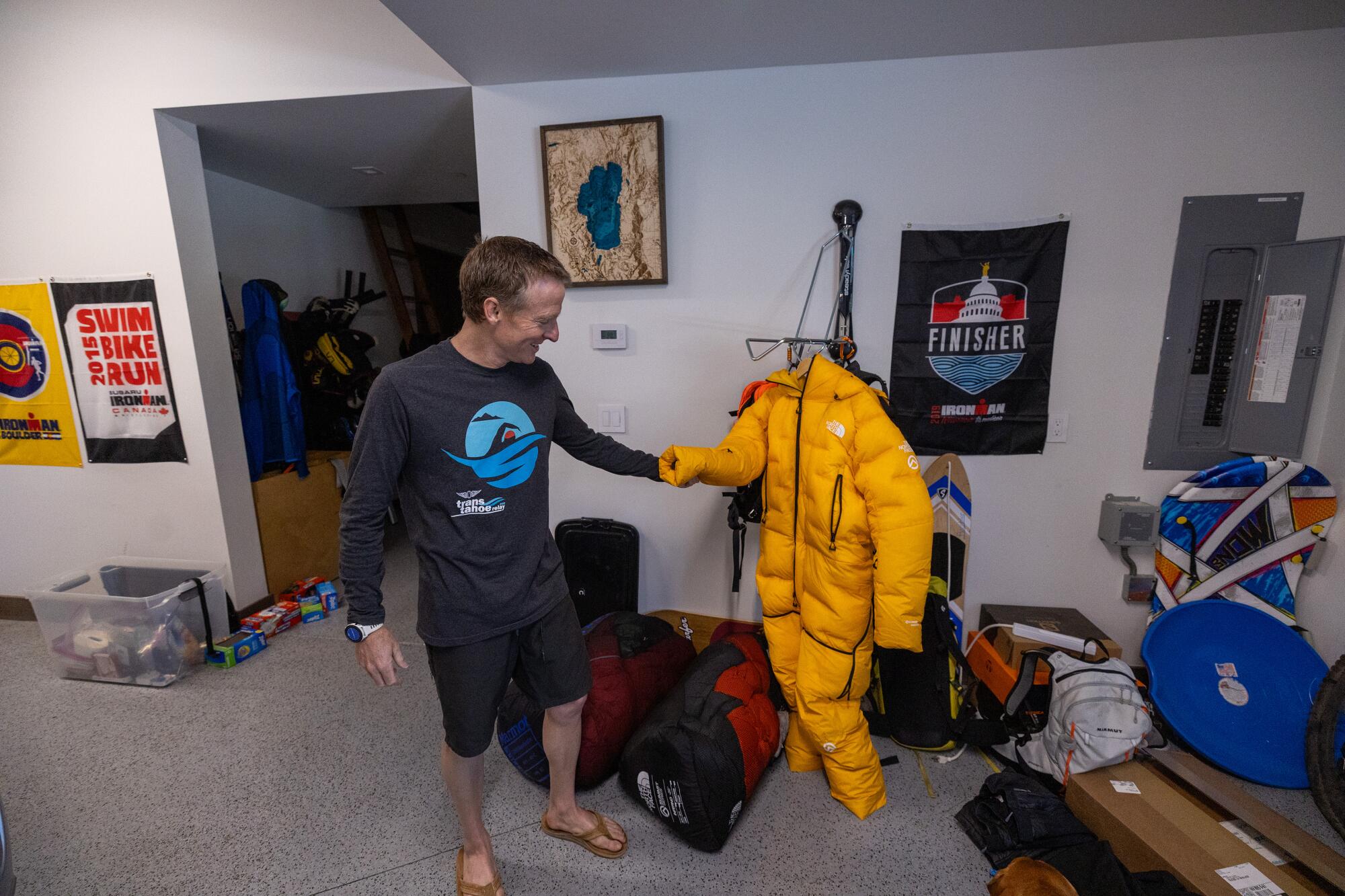
Graham Cooper is no stranger to grueling physical challenges. He has competed in the Ironman World Championship 11 times and has won the 100-mile Western States Endurance Run.
Worse is the Khumbu Icefall, a glacier just above the southern base camp. It’s best known for wide spine-tingling crevasses spanned by flimsy-looking aluminum ladders lashed together with rope. Climbers have to walk across those ladders, wearing big boots and crampons, as they make multiple trips back and forth to advanced camps to acclimatize before finally heading for the summit.
As dangerous as it is for the mostly foreign climbers and guides, the odds are even worse for the local Sherpas, who regularly traverse the Khumbu ferrying equipment — tents, food, oxygen canisters — for the climbing teams. Last year, the deadliest climbing season in Everest history, three Sherpas were killed in the Khumbu when a towering block of ice collapsed and buried them.
In six seasons climbing the southern route, from 2009 to 2014, Ballinger said he passed through the Khumbu 38 times and had two close calls. While nobody on his teams lost their lives there, he helped recover the bodies of other climbers who had not been so lucky.
Finally, he did the math and concluded there was no way he could get through a whole career — 20 or 30 years — without losing someone he was responsible for in the Khumbu.
“I just couldn’t do it anymore,” Ballinger said. “I just couldn’t justify the risk.”
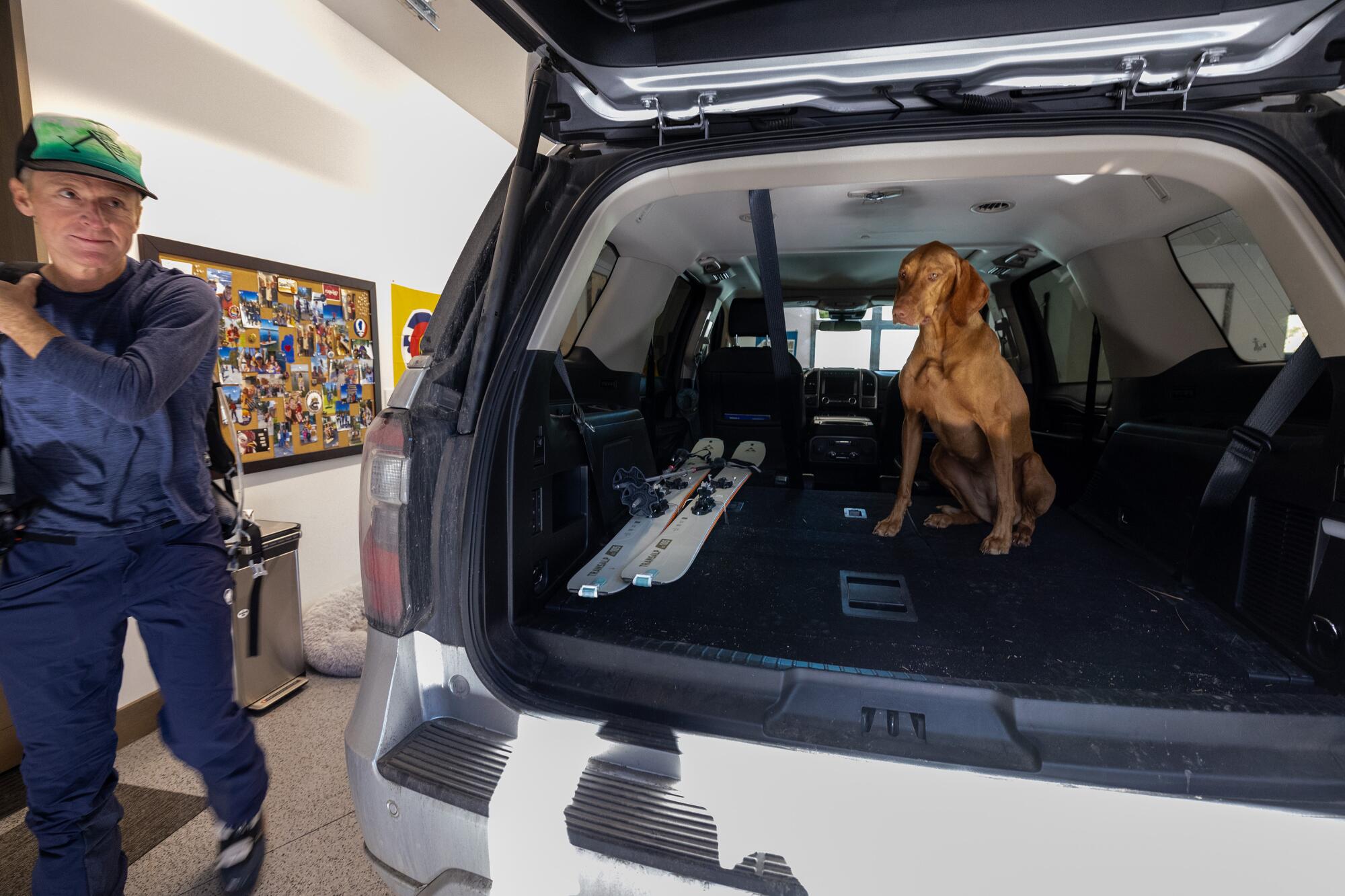
Graham Cooper loads skis into his SUV, preparing for a back-country exercise session with his loyal dog, Busy.
Ballinger’s data-driven approach and stellar track record were enough to win over Cooper.
And he has been willing to wait.
He was ready to climb Everest four years ago, but when China shut down expeditions to its side of the mountain in 2020 in response to the COVID-19 pandemic, Ballinger stuck to his principles and refused to resume climbing with the crowds in Nepal. This is the first year since the pandemic that the Chinese side has been open.
The Alpenglow team, which includes 26 clients, guides and Sherpas hoping to reach the summit, were originally scheduled to begin their expedition in late April. After a late permitting change from the Chinese government, that date has been pushed back to May 7.
Cooper has competed in the Ironman World Championship in Hawaii 11 times and has won the legendary Western States Endurance Run, a 100-mile ultra-marathon. He is not a man accustomed to sitting around. “I’m feeling ready and anxious to get going,” he texted a reporter last week.
When not trying to sleep in his hypoxic tent, Cooper has spent his training days in Tahoe on back-country skis doing laps up and down a mountain, his 3-year-old dog, a Vizsla named “Busy,” at his heels. Indoors, he straps on a hypoxic mask hooked to the same motor he uses for the sleeping tent and rides a stationary bike an hour at a time. Or climbs a StairMaster. Or throws on his mountaineering boots and a heavy backpack and trudges up and down slopes.
Why?
“I’m addicted to doing this kind of stuff,” said Cooper, who ran his first marathon when he was 13. “I just feel like a fundamentally happier person when I’m training.”
Ballinger leads clients on bucket list climbs all around the globe. Many of the treks present more interesting technical challenges than Everest. Almost all of them feel like wild outposts compared with the circus vibe on Everest’s south side.
Still, he gets poetic when he describes why so many clients are drawn to the world’s tallest summit.
“Because it’s so hard,” he said. It takes incredible fitness, mental fortitude and a heavy dose of luck to make it to the top. And no matter how many precautions you take, there’s that uncontrollable element of risk.
“It’s not just a battle for success, it’s a battle for survival up there,” Ballinger said. “That’s something that many of us have not experienced otherwise. I think that really captures people.”

Business
Fight between Waymo and Santa Monica goes to court

Waymo is taking the city of Santa Monica to court after the city ordered the company to cease charging its autonomous vehicles at two facilities overnight, claiming the lights and beeping at the lots were a nuisance to residents.
The two charging stations at the intersection of Euclid Street and Broadway have been a sour point for neighbors since they began operating roughly a year ago. Some residents have told The Times they’ve been unable to sleep because of the incessant beeping from Waymos maneuvering in and out of charging spots on the lot 24 hours a day.
Last month, the city ordered Waymo and the company that operates the charging stations, Voltera, to stop overnight operations at the sites, arguing that the light, noise and activity there constitute a public nuisance. Instead of complying, Waymo has turned around and filed a suit against the city, asking the court to intervene.
“Waymo’s activities at the Broadway Facilities do not constitute a public nuisance,” the company argued in its complaint, filed Wednesday in Los Angeles County Superior Court. “Waymo faces imminent and irreparable harm to its operations, employees, and customers.”
A spokesperson for the city did not immediately respond to a request for comment.
According to the suit, the city was aware that the Voltera charging facilities were to operate and maintain a commercial electric vehicle fleet 24 hours a day, and the city approved its use when it approved the permits for the stations.
The rift between the company and some Santa Monica residents began as soon as the vehicles began utilizing the 24-hour charging stations, which have overnight staffing, lights and cars beeping as they reverse in and out of parking spots. Tensions got so bad that some residents took to blocking the path of the driverless vehicles, blocking the driveways into the charging stations, and placing orange cones in the area to hinder their routes and create backups, a practice several have called “stacking the Waymos.”
Meanwhile, employees at the charging stations have called police several times as a result, although no arrests have been made. Waymo also unsuccessfully attempted to obtain a temporary restraining order against one resident who had allegedly repeatedly blocked the vehicles.
On Nov. 19, the city ordered Waymo to stop charging its autonomous cars at the two lots overnight or face the possibility of legal action. Waymo declined and instead sued the city last week after negotiations with the city on mitigation measures to the lots fell apart.
According to the lawsuit, Waymo and Voltera representatives reached out to the city after the Nov. 19 order, looking for ways to mitigate the noise and lights from the lots, including initiating a software update that would change the vehicles’ path to the charging stations. But after a meeting on Dec. 15 with the city, no agreement was reached, the company said in its complaint.
“We are disappointed that the City has chosen an adversarial path over a collaborative one,” a spokesperson for Waymo said in a statement.
“The City’s position has been to insist that no actions taken or proposed by Waymo would satisfy the complaining neighbors and therefore must be deemed insufficient.”
The company also blasted the city’s handling of the dispute, arguing that despite facing a budget crisis, city officials have adopted a contentious strategy against business.
“The City of Santa Monica’s recent actions are inconsistent with its stated goal of attracting investment,” the company said in a statement. “At a time when the City faces a serious fiscal crisis, officials are choosing to obstruct properly permitted investment rather than fostering a ‘ready for business’ environment.”
The lawsuit is just the latest legal battle for the Alphabet-owned company, which has been rapidly expanding across California, making the white, driverless vehicles more commonplace.
Two years ago, the company was sued by the city of San Francisco, which argued that the California Public Utilities Commission shouldn’t have handed Waymo permits to expand and operate in the city, and that the regulatory agency had abdicated its responsibilities.
The California 1st District Court of Appeal disagreed, and ruled against the city.
This past June, Waymo announced it would expand its service area to 120 square miles in Los Angeles County, with Waymos operating in Playa del Rey, Ladera Heights, Echo Park, Silver Lake and Hollywood.
In November the company launched its ride-hailing service to now operate across Los Angeles County freeways, as well as in the San Francisco Bay and Phoenix.
Since it launched in Santa Monica, the company argues it has done more than a million trips in the city and in November alone, recorded more than 50,000 rides starting or ending there.
“The [charging] site has enabled Waymo to provide a safe, sustainable and accessible transportation option to city residents,” Waymo said in the statement.
Business
Video: Uber Clears Violent Felons to Drive

new video loaded: Uber Clears Violent Felons to Drive
By Emily Steel, Christina Shaman, Zach Caldwell, David Jouppi and Thomas Trudeau
December 22, 2025
Business
How private investors stand to profit from billions in L.A. County sex abuse settlements

Walking out of a Skid Row market, Harold Cook, 42, decides to play a game.
How long after opening YouTube will it take for him to see an ad asking him to join the latest wave of sex abuse litigation against Los Angeles County?
“I can literally turn my phone on right now, something’s going to pop up,” said Cook, opening the app.
Within a few seconds, a message blares: “They thought you’d never speak up. They figured you was too young, too scared, too Black, too brown, too alone. … L.A. County already had to cough up $4 billion to settle these cases. So why not you?”
Since the historic April payout to resolve thousands of claims of sex abuse in county-run facilities, law firms have saturated L.A.’s airwaves and social media with campaigns seeking new clients. For months, government officials have quietly questioned who is financing the wall-to-wall marketing blitz.
The ad Cook heard was from Sheldon Law Group, one of several law firms active in sex abuse litigation in California that receive backing from private investors, according to loan notices and SEC filings. The investors, which often operate through Delaware companies, expect to profit from the payouts to resolve the cases.
Sheldon, based in Washington, D.C., has been one of the most prolific L.A. advertisers. The firm has already gathered roughly 2,500 potential clients, according to a list submitted to the county. The lawsuits started being filed this summer, raising the prospect of another costly settlement squeezed out of a government on the brink of a fiscal crisis.
“We act in the best interests of our clients, who are victims in every sense of the word and have suffered real and quite dreadful injuries,” a spokesperson for Sheldon Law Group said in a statement. “Without financial and legal support, these victims would be unable to hold the responsible parties, powerful corporate or governmental defendants, accountable.”
The financing deals have raised alarms among lawmakers, who say they want to know what portion of the billions poised to be diverted from government services to victims of horrific sex abuse will go to opaque private investors.
Kathryn Barger, a member of the L.A. County Board of Supervisors, said she was contacted by a litigation investor who sought to gauge whether sex abuse litigation could be a smart venture. “This is so predatory,” Barger told The Times.
(Juliana Yamada/Los Angeles Times)
“I’m getting calls from the East Coast asking me if people should invest in bankrupting L.A. County,” Supervisor Kathryn Barger said. “I understand people want to make money, but I feel like this is so predatory.”
Barger said an old college friend who invests in lawsuits reached out this spring attempting to gauge whether L.A. County sex abuse litigation could be a smart venture. Barger said the caller referred to the lawsuits as an “evergreen” investment.
“That means it keeps on giving,” she said. “There’s no end to it.”
The county has spent nearly $5 billion this year on sex abuse litigation, with the bulk of that total coming from the $4-billion deal this spring — the largest sex abuse settlement in U.S. history.
The April settlement is under investigation by the L.A. County district attorney office following Times reporting that found plaintiffs who said they were paid by recruiters to join the litigation, including some who said they filed fraudulent claims. All were represented by Downtown LA Law Group, which handled roughly 2,700 plaintiffs.
Downtown LA Law Group has denied all wrongdoing and said it “only wants justice for real victims.” The firm took out a bank loan in summer 2024, according to a financing statement, but a spokesperson said they had no investor financing.
Lawyers who take the private financing say it’s a win-win. Investors make money on high-interest rate loans while smaller law firms have the capital they need to take on deep-pocketed corporations and governments. If people were victimized by predators on the county’s payroll, they deserve to have a law firm that can afford to work for free until the case settles. Money for investors, they emphasize, comes out of their cut — not the clients’.
But critics say the flow of outside money incentivizes law firms to amass as many plaintiffs as possible for the wrong reasons — not to spread access to justice, but rather ensure hefty profit for themselves and their financial backers.
“The amount of money being generated by private equity in these situations — that’s absurd,” said former state lawmaker Lorena Gonzalez, who wrote the 2019 bill that opened the floodgate for older sex abuse claims to be filed. “Nobody should be getting wealthy off taxpayer dollars.”
For residents of L.A.’s poorest neighborhood, ads touting life-changing payouts have started to feel inescapable.
Waiting in line at a Skid Row food shelter, William Alexander, 27, said his YouTube streaming is punctuated by commercials featuring a robotic man he suspects is AI calling on him to sue the county over sex abuse.
Across the street, Shane Honey, 56, said nearly every commercial break on the news seems to feature someone asking if he was neglected at a juvenile hall.
In many of the ads, the same name pops up: Sheldon Law Group.

Austin Trapp, a case worker in Skid Row, was among several people in the neighborhood who said ads seeking people to join sex abuse litigation against L.A. County have become increasingly common.
(Gina Ferazzi/Los Angeles Times)
Sheldon’s website lists no attorneys, but claims the firm is the “architect” behind “some of the largest litigations on Earth.” They list their headquarters online at a D.C. virtual office space, though the owners on their most recent business filing list their own addresses in New York. The firm’s name appears on websites hunting for people suffering from video game addiction, exposure to toxins from 9/11, and toe implant failure.
Sheldon Law Group was started by the founder of Legal Recovery Associates, a New York litigation funding company that uses money from investors including hedge funds to recruit large numbers of plaintiffs for “mass torts,” cases where many people are suing over the same problem, according to interviews with former advisers, court records and business filings.
Those clients are gathered for one of their affiliated law firms, including Sheldon Law Group, according to two people involved in past transactions.
Ron Lasorsa, a former Wall Street investment banker who said he advised Legal Recovery Associates on setting up the affiliate law firms, told The Times it was built to make investors “obscenely rich.”
“It’s extremely profitable for people who know what the hell they’re doing,” Lasorsa said.
The idea, he says, emerged from a pool cabana at a Las Vegas legal conference called Mass Torts Made Perfect in fall 2015.

A man visiting friends on Skid Row holds up his phone showing an ad recruiting clients for sex abuse case in Los Angeles County on December 11, 2025 in Los Angeles, California.
(Gina Ferazzi/Los Angeles Times)
Lasorsa had just amassed 14,000 clients for personal injury lawsuits in one year using methods that, he now says, were legally dubious. A favorite at the time: using call centers in India that had access to Americans’ hospital records and phoning the patients to see if they were feeling litigious.
Near the pool at a Vegas hotel, Lasorsa said Howard Berger, a former hedge fund manager barred by the SEC from working as a broker, asked if he could turbocharge the caseload of Legal Recovery Associates, where he worked as a consultant.
Lasorsa said he soon teamed up with the founders of LRA — Gary Podell, a real estate developer, and Greg Goldberg, a former investment manager — to create “shell” law firms based in Washington. The nation’s capital is one of the few places where non-lawyers can own a law firm, profiting directly from case proceeds.
Goldberg, who is not licensed to practice law in D.C., would become a partner in at least six D.C. law firms including Sheldon Law Group by 2017, according to a contract between Legal Recovery Associates and a hedge fund that financed the firms’ cases.
Sheldon, which said it was responding on behalf of Podell, said in a statement that all their partners are lawyers, though declined to name them. Goldberg did not respond to a repeated request for comment.
The Sheldon spokesperson said Legal Recovery Associates is a separate entity that engages in its “own business and legal activities.”
Investors typically make money on litigation by providing law firms with loans, which experts say carry interest rates as high as 30%, representing the risk involved. If the case goes south, investors get nothing. If it settles, they make it all back — and then some.
Lasorsa said he helped the company gather 20,000 claims using the same Indian call centers before a bitter 2019 split. He later accused the owners of unethical behavior, which led to a half-million dollar settlement and a non-disparagement agreement that he said he decided to breach, leading to a roughly $600,000 penalty he has yet to pay, according to a court judgment.
Lasorsa was also ordered to delete any disparaging statements he’d made, according to the judgment.
D.C. law firms with non-lawyers as partners must have the “sole purpose” of providing “legal services,” according to the district’s bar. Some attorneys have argued no such service was provided by the firms associated with Legal Recovery Associates.
Troy Brenes, an Orange County attorney who co-counseled with one of the firms over flawed medical devices, accused the company of operating a “sham law firm” as part of a 2022 court battle over fees.
“The sole purpose … appears to have been to allow non-lawyers to market for product liability cases and then refer those cases to legitimate law firms in exchange for a portion of the attorney fees without making any effort to comply with the D.C. ethics rules,” Brenes wrote.
A spokesperson for Sheldon and LRA noted in a statement that “no court or arbitration panel has ever concluded” that its business structure violates the law.
In the medical device cases, the affiliate firm, which was responsible for funding the marketing campaign, took 55% of recoverable attorney fees, according to an agreement between the two firms. The profit divide mirrors the 55/45 breakdown between Sheldon Law Group and James Harris Law, a two-person Seattle firm they have partnered with on the L.A. County sex abuse cases, according to a retainer agreement reviewed by The Times.

A person on Skid Row in downtown L.A. shows an ad on their phone seeking plaintiffs to joint a lawsuit over sexual abuse in juvenile halls.
(Gina Ferazzi/Los Angeles Times)
This summer, ads linking to a webpage with the name of James Harris appeared online, telling potential clients they could qualify in 30 seconds for up to $1 million. When a Times reporter entered a cell-phone number on one of the ads, a representative who said they worked for the firm’s intake department called dozens of times.
After The Times described these marketing efforts in a story, Harris emphasized in an email that he did not know about the ads or the persistent calls and said they were done by his “referring firm.” The landing page the ads led to was replaced with the name of Sheldon Law Group.
Harris said his firm and Sheldon, which he described as “functioning as a genuine and independent co counsel law firm,” have “been highly selective and have only prosecuted cases that we believe are legally and factually meritorious.”
“I continue to believe that lawyer advertising, when conducted ethically and without misleading claims, serves as a vital tool for raising public awareness about legal rights and available recourse, particularly for survivors of abuse seeking justice,” he said.
Over the last five years, experts say, the practice of funding big mass tort cases has boomed in the U.S.
Of the five main firms in L.A. County’s initial $4-billion sex abuse settlement, two took money from outside investors shortly before they began suing the county, according to public loan filings.
The loans to both Herman Law, a Florida-based firm that specializes in sex abuse cases, and Slater Slater Schuman, a New York-based personal injury firm, came from Delaware-registered companies. Deer Finance, a New York City litigation funding firm that connects investors with lawyers, is listed on business records for both companies.
The loan documents do not specify which of the firms’ cases were funded, but show each deal was finalized within months of the firms starting to sue L.A. County for sex abuse. Neither firm responded to questions about how the outside funding was used.
Slater, which received the loan in spring 2022, represents more L.A. County plaintiffs than any other firm, by far.
Slater’s caseload surged after the county signaled its plan to settle for $4 billion in October 2024. Several of the main attorneys on the case told The Times they stopped advertising at that point, reasoning that any new plaintiffs would now mean less money for the existing ones.
The next month, Slater Slater Schulman ran more than 700 radio ads in Los Angeles seeking juvenile detention abuse claims, according to X Ante, a company that tracks mass tort advertisements.
By this summer, the number of claims jumped from roughly 2,100 to 3,700, according to court records, catapulting Slater far beyond the caseload of any other firm.
This fall, another Delaware-registered company took out a lien on all of Slater’s attorney fees from the county cases, according to an Oct. 6 loan record. The law firm assisting with the transaction declined to comment.
“These are extraordinarily complex cases and litigating these cases effectively requires resources,” said an outside attorney representing Slater in a statement, responding to questions from The Times.
The firm, which also represents roughly 14,000 victims in the Boy Scouts sex abuse cases, was singled out by the judge overseeing the litigation this fall for “procedural and factual problems” among its plaintiffs. The firm was one of several called out by insurers in the litigation for using hedge fund money to “run up the claim number.”
The firm has said they’re working “tirelessly” to address the issues and justice for survivors is its top priority.

April Mannani, who says she was assaulted in the 1990s by an officer while she was housed at MacLaren Children’s Center, said she feels lawyers on the sex abuse cases are putting profits ahead of the best interests of clients.
(Jimena Peck/For The Times)
Many plaintiffs told The Times they were discouraged to see how much money stood to be made for others off their trauma.
April Mannani, 51, sued L.A. County after she said she was raped repeatedly as a teenager at MacLaren Children’s Center, a shelter now notorious for abuse. Mannani accepts that her lawyers are entitled to a cut for their work on the case, but said she was disheartened watching the numbers of cases suddenly skyrocket this year. With the district attorney investigating, a pall has been cast over the entire settlement.
“We’ve been made fools of and we were used for financial gain,” she said. “They all just see it as a money grab.”
That firm that represents her, Herman Law, has filed roughly 800 cases against L.A. County. Herman Law took out a loan in 2021 from a Delaware-registered company affiliated with Deer Finance, according to a loan notice. The firm said they use traditional bank loans for “overall operations.”
Herman Law is the most prolific filer of county sex abuse cases outside of L.A. County since the state changed the statute of limitations.
Herman Law has filed about half of these roughly 800 sex abuse lawsuits that have been brought outside of L.A. County, according to data reviewed by The Times.
Herman Law has sued several tiny counties, where public officials say they’ve been inundated with advertisements on social media and TV looking for plaintiffs. Some counties say they threw out relevant records long ago and have no way to tell if the alleged victim was ever in local custody.
A judge fined Herman Law about $9,500 last month for failing to dismiss Kings County from a lawsuit despite presenting no evidence the county ever had custody of the victim, calling the claim “factually frivolous” and “objectively unreasonable.” An attorney for Herman Law said in a court filing the client believed she’d been in a foster home there, and the lack of records didn’t conclusively establish anything.
“There are not records. There’s nothing that exists,” said Jason Britt, the county administrative officer for Tulare County, which has been sued at least eight times by Herman Law. “Counties at some point are not gonna be able to operate because you’re essentially going to bankrupt them.”
The firm said its clients are always its top priority.
“No lender or financial relationship has ever influenced, directed or played any role in legal strategy, client decisions or case outcomes, including any matters involving the Los Angeles County,” the firm said. “Herman Law’s work is driven solely by our mission to advocate for survivors in their pursuit of justice and healing.”
Joseph Nicchitta, L.A. County’s acting chief executive officer, said he believed the region’s social safety net was now “an investment opportunity.” In an October letter to the State Bar, he called out the “explosive growth” of claims, arguing a handful of firms were “competing to bring as many cases as possible” to the detriment of their existing clients.
He estimated that attorney fees in the lawsuit would amount to more than $1 billion. “It begs reform,” he wrote.
-

 Iowa1 week ago
Iowa1 week agoAddy Brown motivated to step up in Audi Crooks’ absence vs. UNI
-

 Iowa1 week ago
Iowa1 week agoHow much snow did Iowa get? See Iowa’s latest snowfall totals
-

 Maine7 days ago
Maine7 days agoElementary-aged student killed in school bus crash in southern Maine
-

 Maryland1 week ago
Maryland1 week agoFrigid temperatures to start the week in Maryland
-

 New Mexico6 days ago
New Mexico6 days agoFamily clarifies why they believe missing New Mexico man is dead
-

 South Dakota1 week ago
South Dakota1 week agoNature: Snow in South Dakota
-

 Detroit, MI1 week ago
Detroit, MI1 week ago‘Love being a pedo’: Metro Detroit doctor, attorney, therapist accused in web of child porn chats
-

 Health1 week ago
Health1 week ago‘Aggressive’ new flu variant sweeps globe as doctors warn of severe symptoms
















